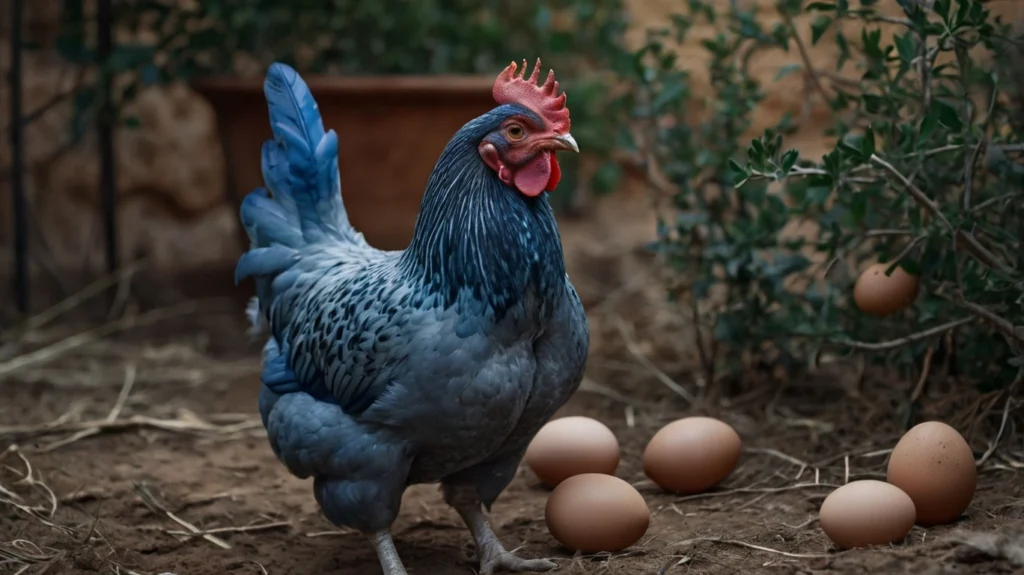Andalusian Chicken Egg Production: What You Can Expect
Imagine walking out to the chicken coop at sunrise. You’re greeted by the soft clucking of your Andalusian chickens. And there, fresh eggs are waiting for you. For many backyard chicken lovers, these morning eggs are a big reason to keep hens.
But what about Andalusian chickens? How much egg production should you expect? We’ll explore their egg-laying patterns, what affects their productivity, and how to get the most from your flock.
Here’s a table summarizing the Andalusian Chicken:
| Attribute | Description |
|---|---|
| Official Name | Gallus gallus domesticus (Andalusian breed) |
| Common Name | Andalusian Chicken |
| Pet Height | 14–18 inches (varies by gender) |
| Pet Weight | 4.5–7 pounds (hens are smaller than roosters) |
| Lifespan | 5–8 years |
| Smartness Level | High (intelligent and curious) |
| Engagement in Play | Moderate (enjoy foraging and exploring) |
| Human-Friendly | Highly friendly, especially if socialized early |
| Animal-Friendly | Good with other chickens but can assert dominance |
| Favorite Food | Grains, vegetables, insects, and treats like mealworms |
Table of Contents
Andalusian Chickens: What Makes Them Unique?
Andalusian chickens are a rare breed from Spain. They are loved by small-scale chicken keepers and homesteaders. Their looks and active nature make them stand out.
They have a medium size and a sleek, elegant look. Their feathers are blue or splash, making them very attractive.
- Size and Appearance: Hens weigh 4.5-5.5 pounds. Their sleek feathers give them a unique look. They stand proudly, making them easy to spot.
- Temperament: Andalusians are calm but can be a bit skittish. They are curious and love to roam freely.
This makes them perfect for chicken keepers who like independent birds. They adapt well to different environments.

Egg-Laying Facts for Andalusian Chickens
Andalusian chickens lay eggs consistently but not too many. Each hen lays 150-200 eggs a year, or 3-4 eggs a week. They offer a steady supply without being too much.
- Egg Characteristics: Their eggs are medium to large with a crisp, white shell. They are great for cooking, baking, or enjoying fresh.
- Age and Peak Production: They start laying eggs at 5-6 months. They lay most eggs from ages 1 to 3, then production slows down.
- Seasonal Changes: They lay more in spring and summer. In winter, they lay fewer eggs as days get shorter and colder.
Factors Affecting Andalusian Egg Production
Several things affect how many eggs your Andalusian chickens lay. Diet and environment are key:
Diet and Nutrition
Their diet should include plenty of protein and calcium. Protein helps with egg formation, and calcium strengthens eggshells. Use high-quality layer feed with oyster shells to boost production.
- Protein Needs: They need 16-18% protein in their diet.
- Supplementing Calcium: Calcium makes eggshells strong and prevents soft-shelled eggs.
Housing and Environment
Andalusians are active and need lots of space. They do well in places where they can forage freely. A clean, well-ventilated coop is crucial to avoid diseases.
- Coop Size: They need at least 4 square feet per bird inside the coop, with more in the run.
- Ventilation and Cleanliness: Regular cleaning prevents infections that can lower egg production.
| Factor | Description | Impact on Egg Production |
|---|---|---|
| Diet | High protein, adequate calcium | Boosts productivity |
| Environment | Spacious, well-ventilated coop | Reduces stress |
| Health | Regular care and parasite control | Maintains consistency |

Health and Stress Levels
Andalusians can be sensitive to sudden changes. It’s best to avoid loud noises, big temperature changes, and too much handling. High stress and health issues like parasites or infections can lower egg production. Make sure your birds have a calm place to lay eggs.
- Parasite Control: Check for mites and lice often to keep eggs healthy.
- Regular Vet Care: Get an annual checkup or when you see signs of sickness.
Managing Egg Production Expectations
Knowing what’s normal helps set realistic egg production goals. Andalusians lay eggs at a moderate rate. This makes them a good choice for those wanting a steady egg supply without too much.
Seasonal Variations
Andalusians lay fewer eggs in winter. Their egg-laying is linked to daylight hours. Shorter days mean fewer eggs. To keep production steady, add extra lighting in the coop.
- Lighting Tips: A small, low-watt bulb on a timer can help in winter.
Molting Periods
Andalusians molt once a year, shedding and growing new feathers. This time, they focus on feather growth, not eggs. It’s a natural break for them to prepare for more laying.
Tips for Boosting Andalusian Egg Production
To increase egg production, follow these steps:
- Provide Nutritious Feed: Use layer-specific feed for the right nutrients.
- Optimize Lighting: Use extra lighting for longer daylight hours.
- Regular Health Checks: Watch for illness signs and provide care quickly.
- Minimize Stress: Let them roam freely and avoid coop overcrowding.
By doing these things, your Andalusians will feel safe and lay eggs regularly. you can create an environment where your Andalusians feel comfortable and secure, leading to steady egg production.
Common Health Concerns Affecting Andalusian Chickens
Andalusians face health issues that can affect egg production. Be aware of these problems:
Egg Binding
Egg binding happens if the egg is blocked inside the hen. It’s caused by diet, exercise, or calcium lack. Look for signs like sluggishness and a swollen belly. A calcium-rich diet and regular health checks can help.
Calcium Deficiency
Calcium is key for strong eggshells. Without enough, hens lay soft or fragile eggs. Crushed oyster shells in their diet can help.
Respiratory Issues
Andalusians can get respiratory infections from drafts or dirty coops. Keep the coop clean and watch for signs like wheezing or discharge.
- Symptoms to Watch For: Sneezing, coughing, lethargy, and less appetite.
Storing and Handling Eggs from Andalusian Chickens
Once your Andalusian chickens start laying eggs, it’s important to store them right. This keeps them fresh for longer.
Collecting and Cleaning Eggs
Collect eggs every day to keep them clean and safe. If an egg is dirty, use a dry cloth to clean it. Washing can remove the protective layer that keeps bacteria out. If you must wash, use warm water and dry them right away.
Proper Storage
Store eggs in a cool, dry place, like below 50°F. Eggs stay fresh on the counter for 14 days if unwashed. They keep well in the fridge for three months.
FAQs on Andalusian Chicken Egg Production
Q1: How many eggs can Andalusian hens lay annually??
Expect 150-200 eggs a year from a healthy Andalusian hen.
Q2: At what age do Andalusian chickens start laying eggs?
At 5-6 months, they typically begin laying eggs.
Q3: What color are Andalusian chicken eggs?
Their eggs are white, medium to large in size.
Q4: Do Andalusian chickens lay eggs year-round?
Egg production is highest in spring and summer. It slows down in winter or during molting.
Conclusion
Andalusian chickens are great for those who want beautiful birds and eggs. They lay eggs well, mostly in warmer months. Their blue feathers add beauty to any flock. With the right care, you’ll enjoy a healthy, productive flock for years.







